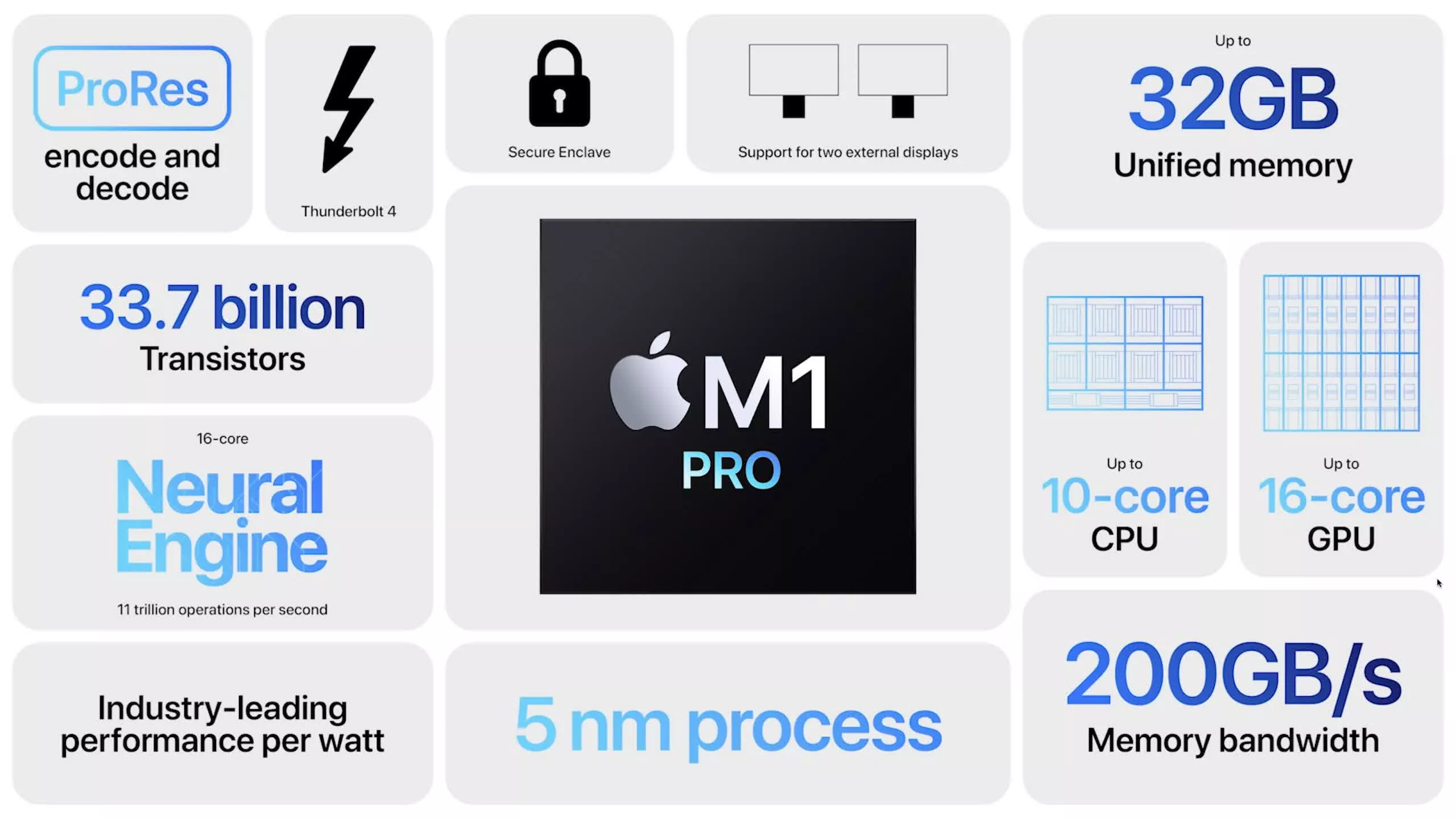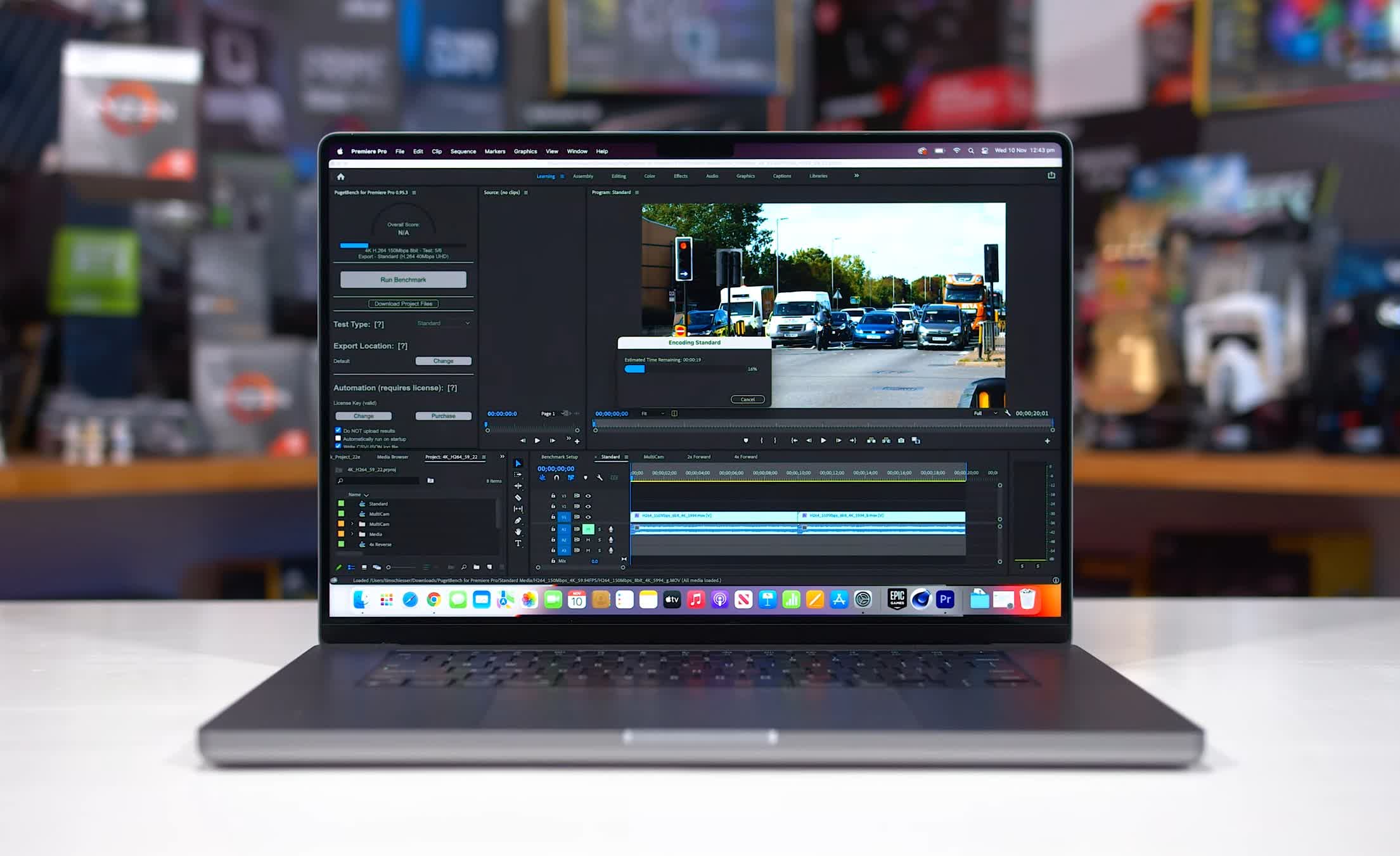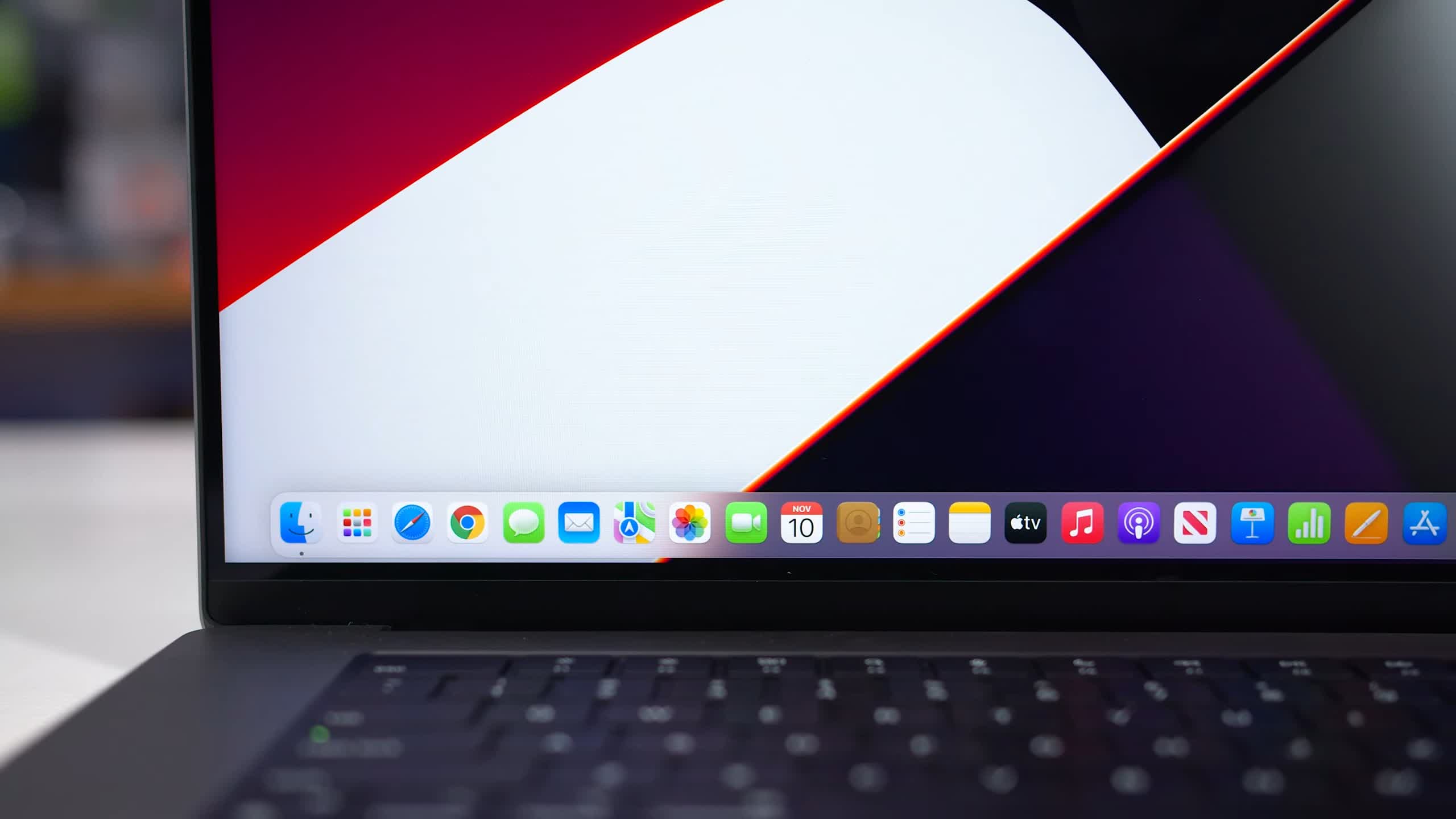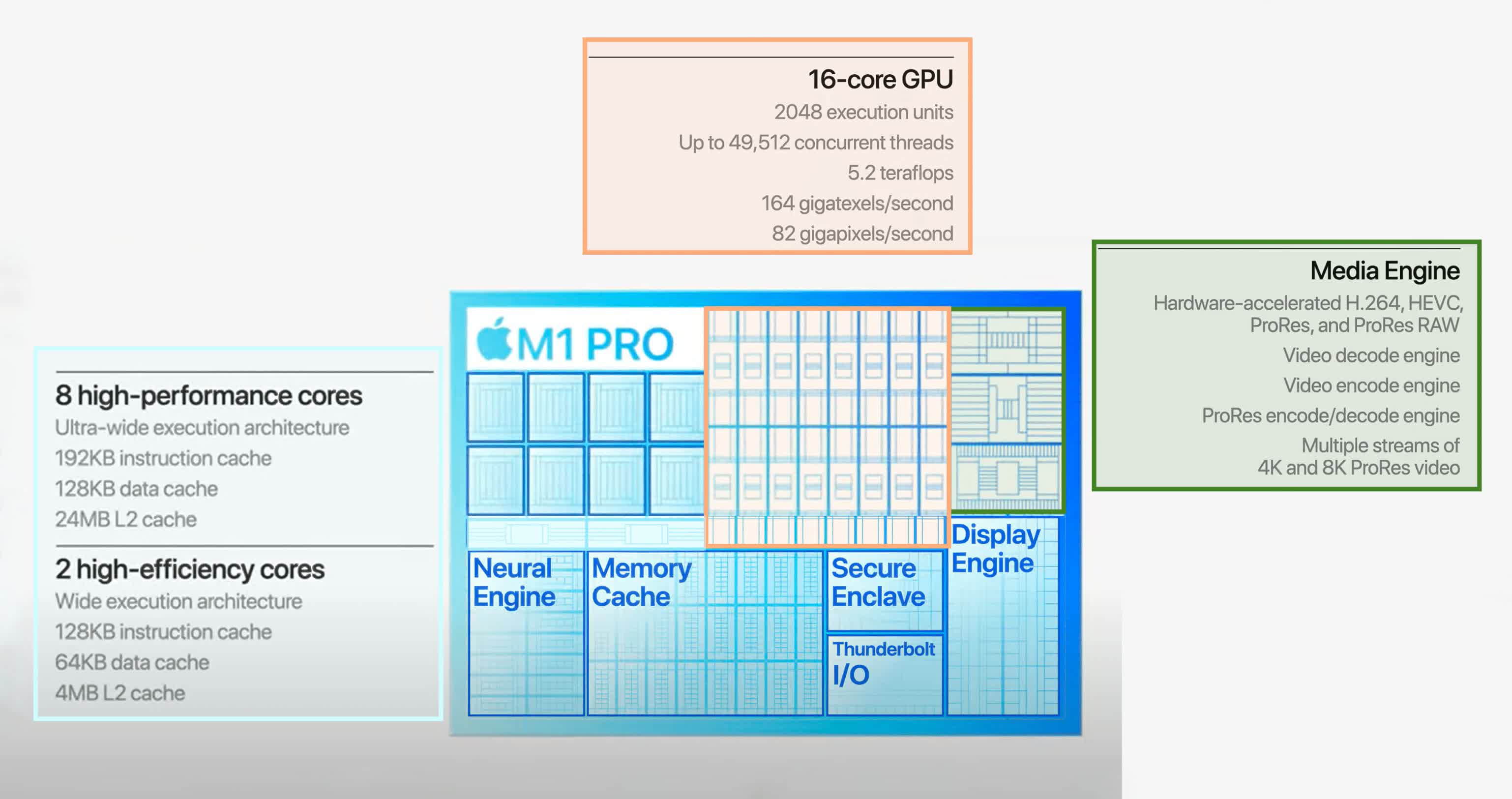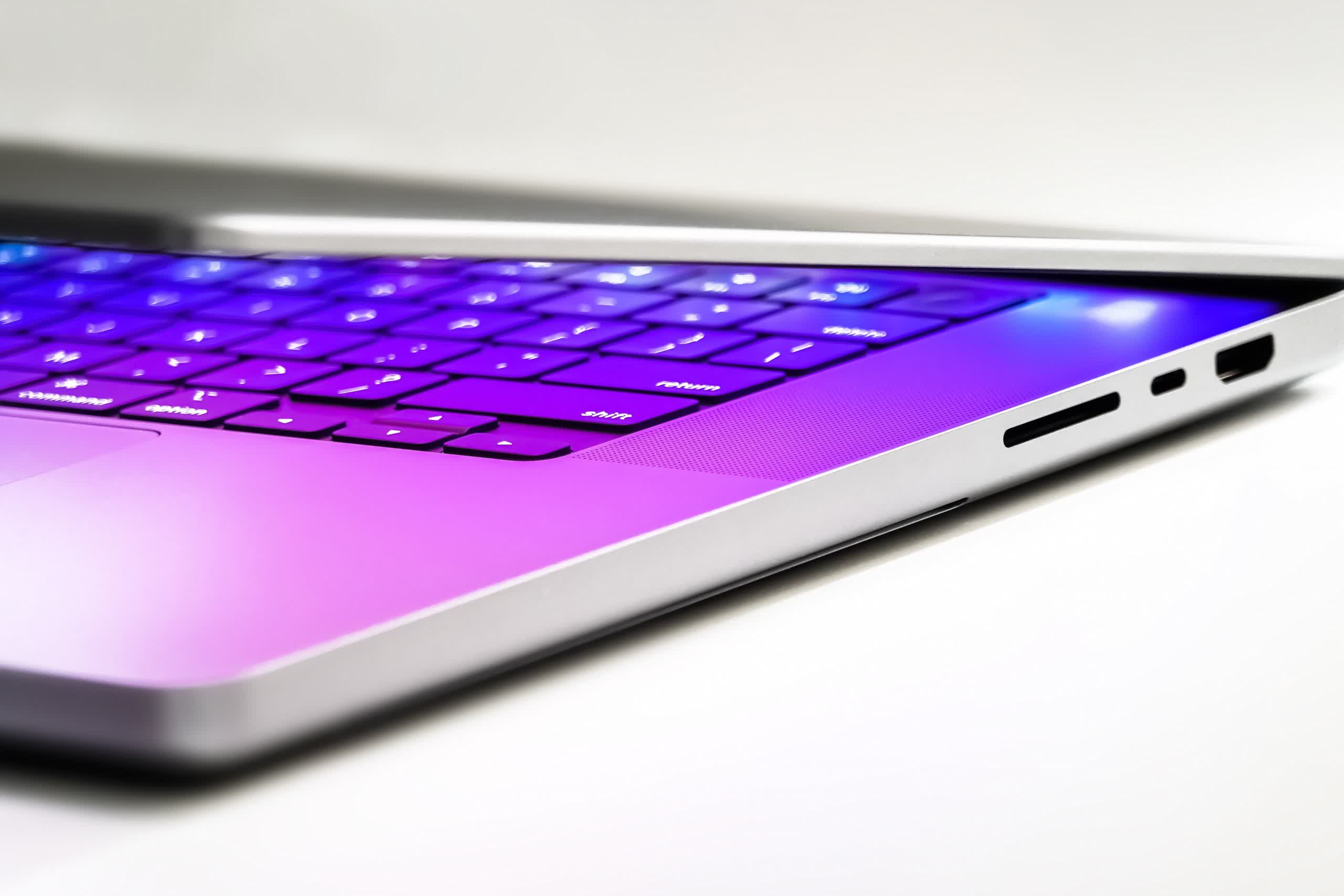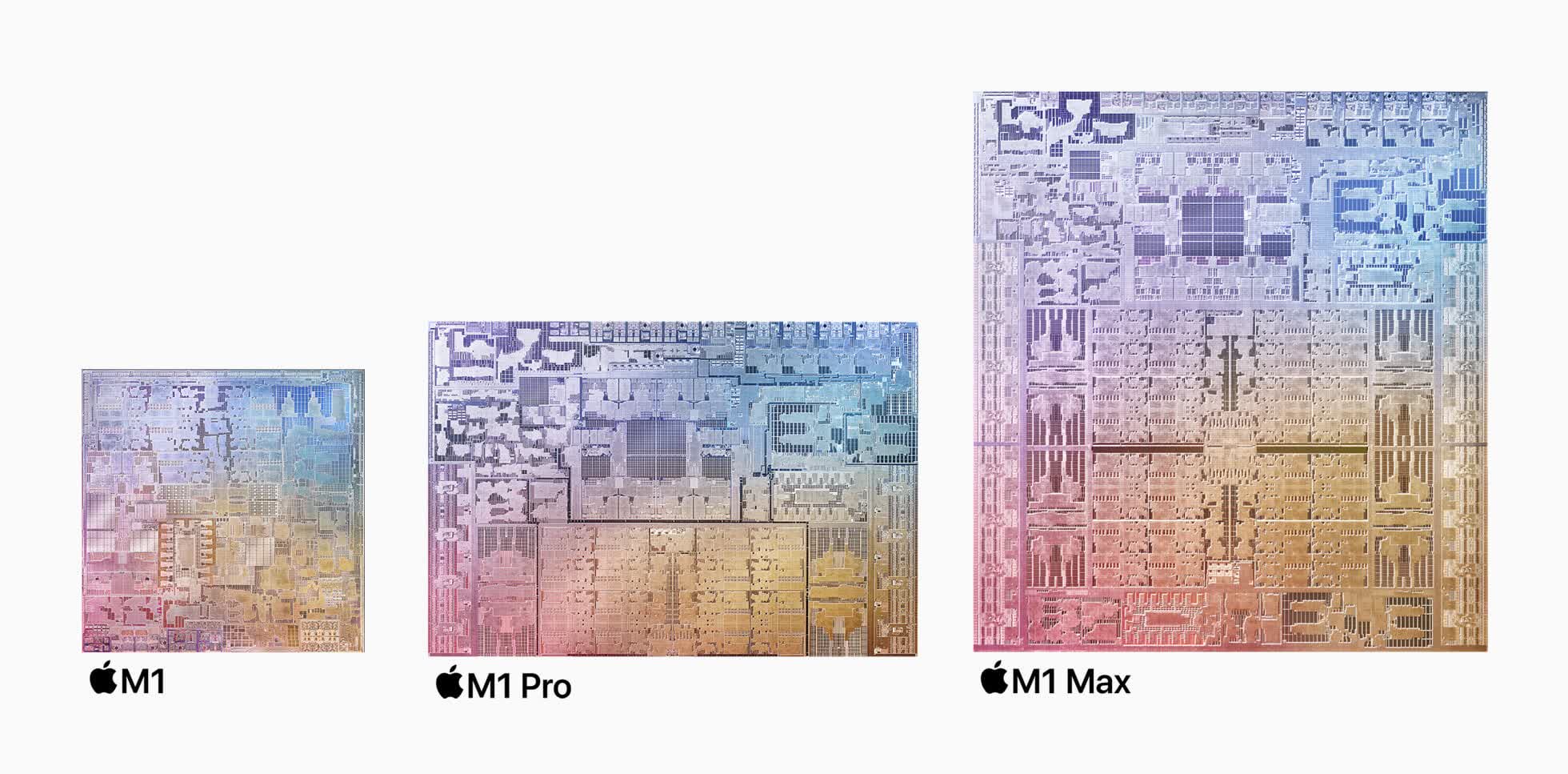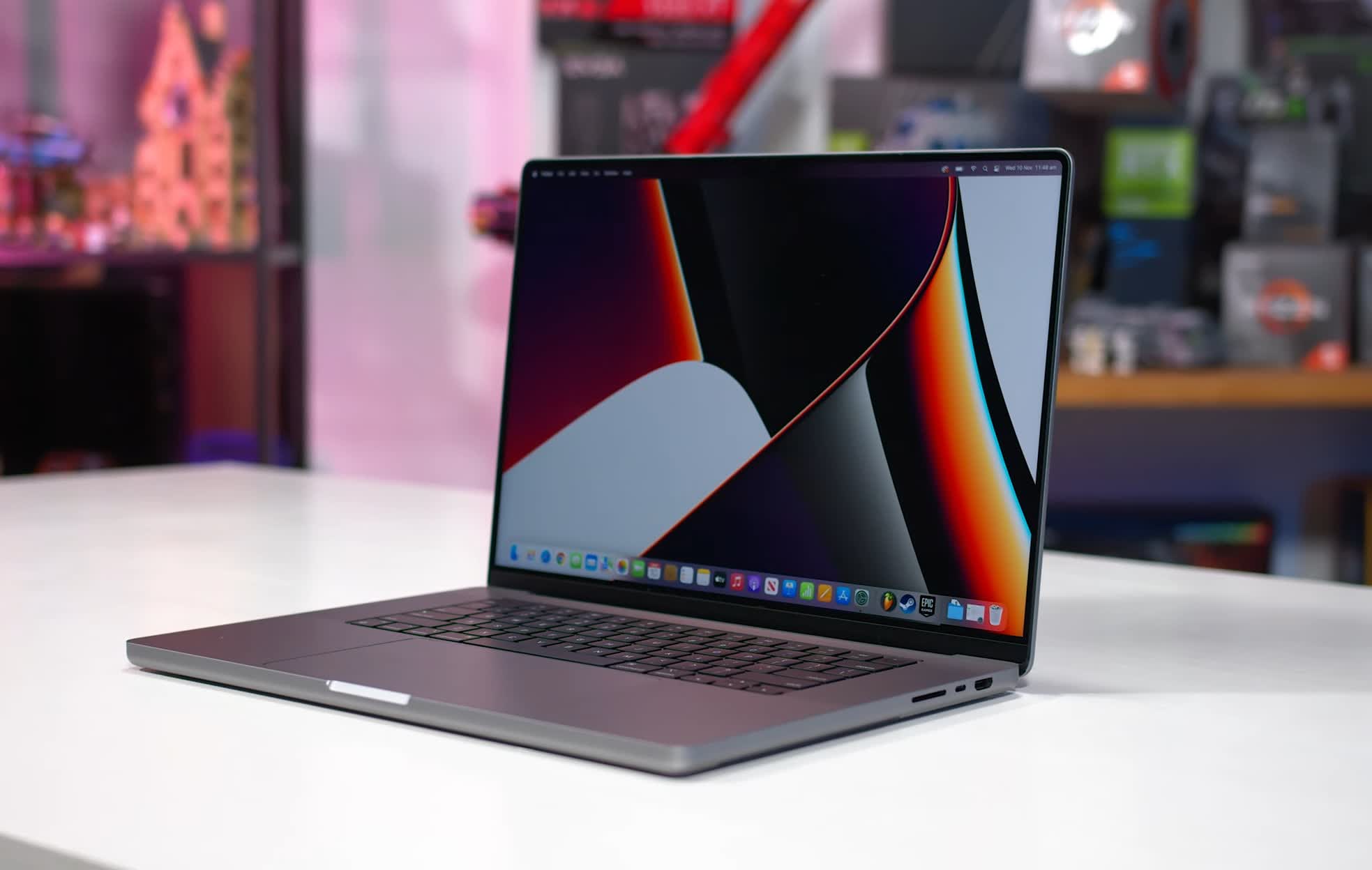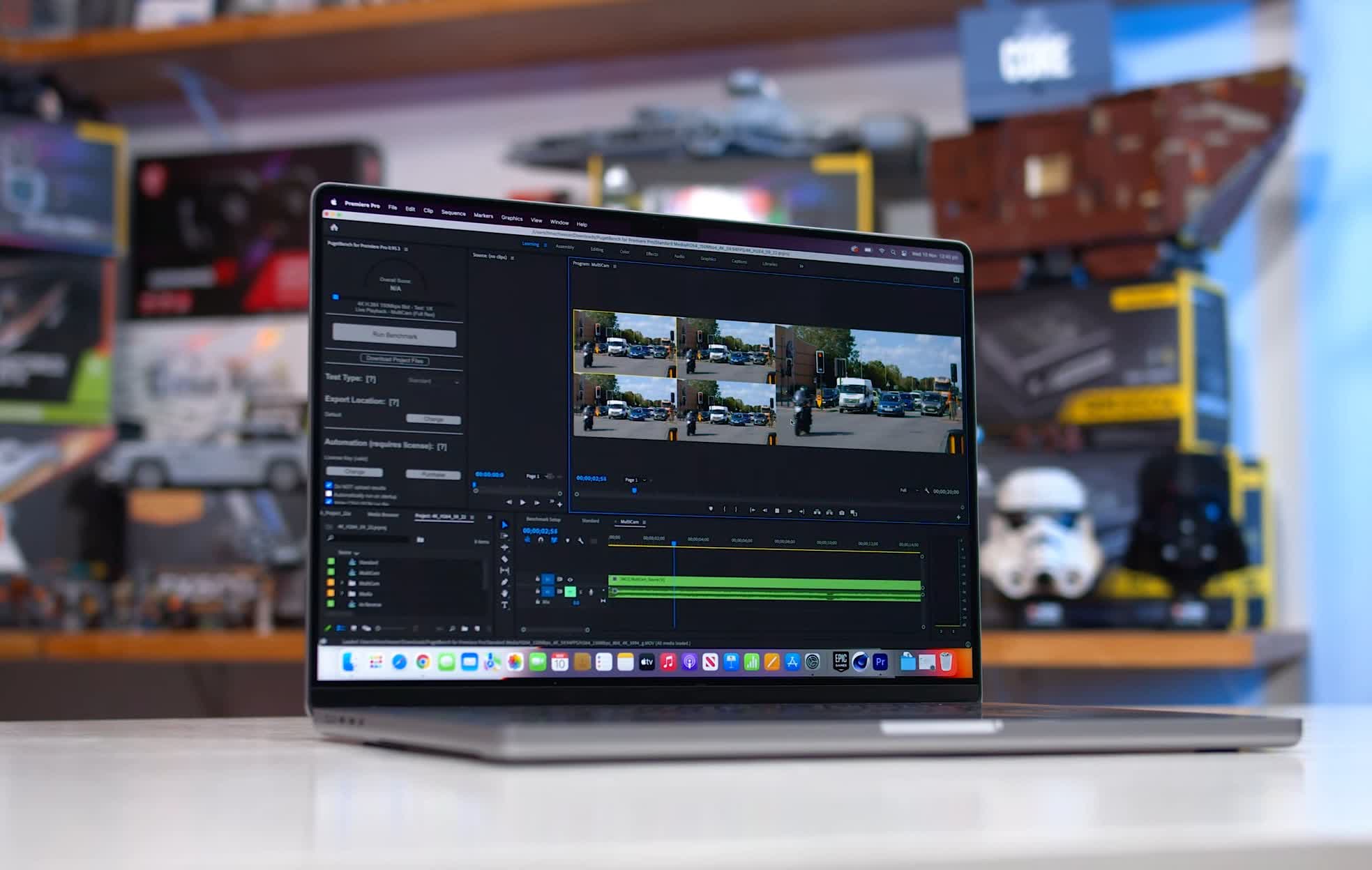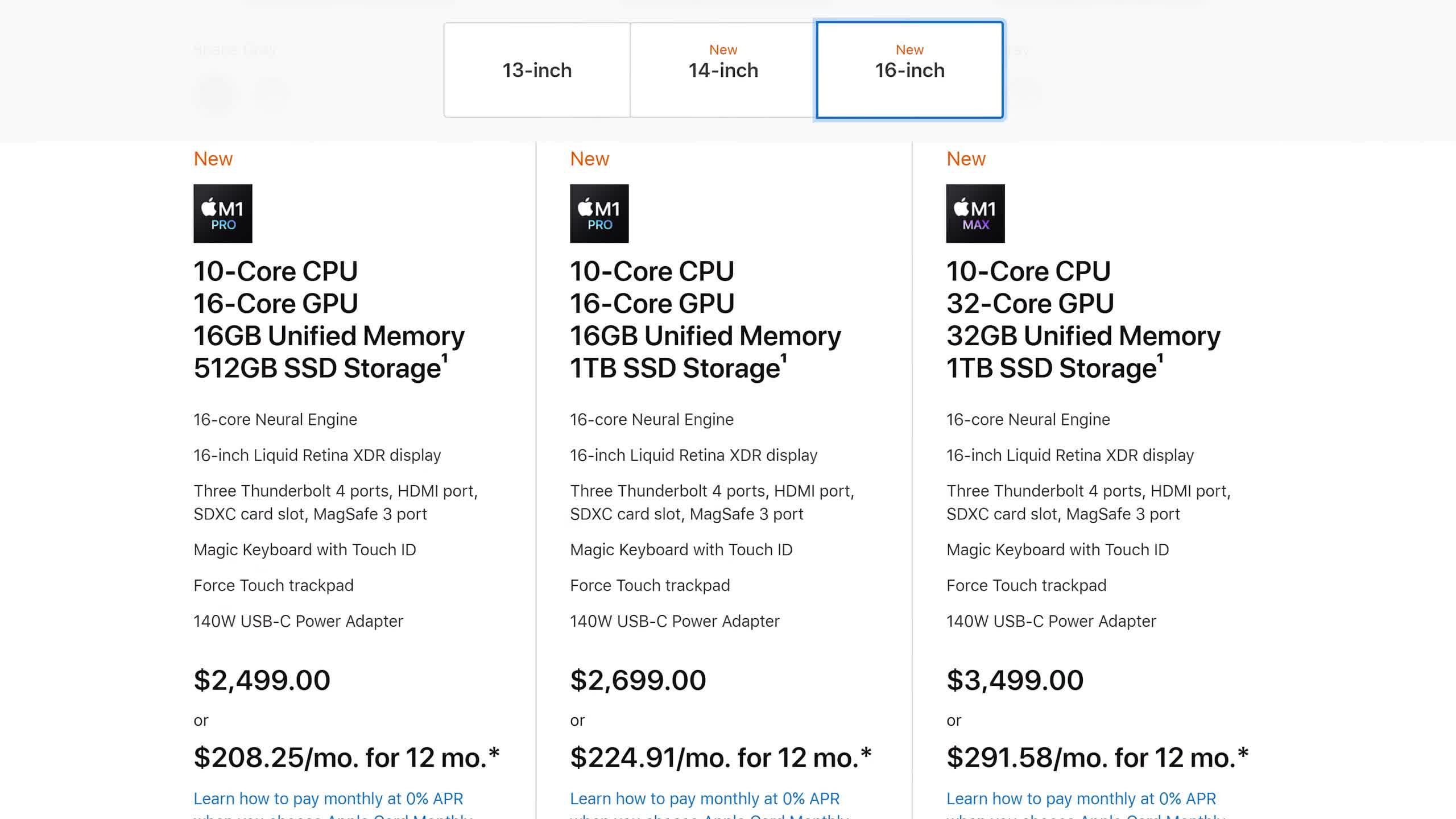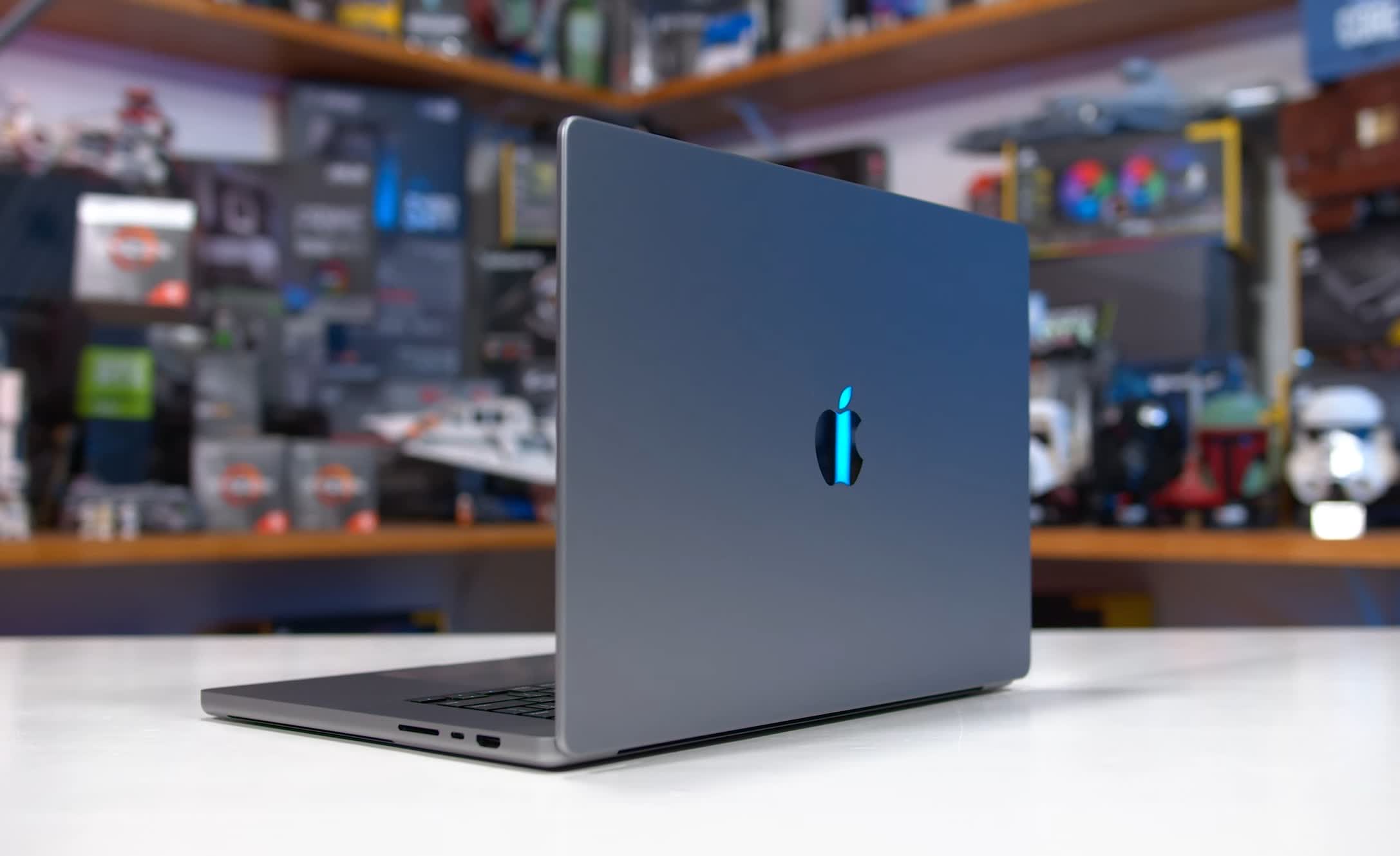Today we're taking our benchmarking to places it's never been before with an in-depth look at an Apple Silicon product. A few weeks ago we bought a new Apple MacBook Pro 16 powered by the M1 Pro SoC, and have been putting it through its paces ever since.
So this review is all about benchmarking the new M1 Pro and properly comparing it to the best x86-based CPUs we have today from AMD and Intel. And by properly comparing, we don't mean running Geekbench and calling it a day. In fact, we won't be running Geekbench at all... we mean running a wide range of real-world multi-platform applications and comparing performance across the best laptop chips available today, all run under fair and equivalent conditions.
This is going to be interesting because it's fair to say there's a lot of hype around Apple M1 silicon and its supposed desktop-destroying performance. With hype there's often overhype and certainly a lot of fanboyism, including taking Apple's in-house benchmarks as gospel, so we'll see how warranted all of that is today.
The Apple M1 Pro is a very different SoC design to the chips we normally review because it uses the Arm architecture family instead of x86. That doesn't mean it's better, it just goes about things in a different way. At the heart of this processor are a maximum of 10 CPU cores, split into 8 high performance Firestorm cores and 2 efficient Icestorm cores in a hybrid design. The Firestorm cores are clocked up to 3.2 GHz and the Icestorm cores hit 2.1 GHz, though this depends on the amount of load in the system and all-core workloads drop those clocks by a few hundred MHz.
On the GPU side we have a 16-core design in the M1 Pro, which goes up to 32 cores in the M1 Max (which is offered in a more expensive version of the same laptop). Connected to the CPU and GPU in a unified design is a 256-bit wide LPDDR5 memory bus providing slightly over 200 GB/s, you can think of this like if an x86 design included quad-channel memory instead of dual-channel, it's certainly a lot of memory bandwidth and much more than you'd get in similar products from Intel or AMD. There's also lots of L2 cache and 24 MB of top level cache on the M1 Pro. Both the top level cache and memory controllers are doubled on the M1 Max design to feed the larger GPU.
Apple has taken the Nvidia approach to naming the M1 Pro by launching two configurations under basically the same name. The top-level design packs the full 10-core CPU and 16-core GPU, but the base design cuts that down to just 8 CPU cores and 14 GPU cores. While this is advertised prominently on their product page for the MacBook Pros, Apple doesn't bother differentiating the actual product name beyond M1 Pro.
For our testing we purchased a 16-inch MacBook Pro with the full M1 Pro configuration. We also chose 16GB of unified memory to match our existing laptop test data that uses 16GB of RAM, and a 512 GB SSD. Apple's upgrades to both RAM and storage are disgustingly expensive, it would have cost an additional $600 to bump that to 32GB of memory and 1TB of SSD. You can't upgrade these components yourself either, so you've got no choice but to pay these prices if you need higher capacities, not that you'd expect anything different from Apple.
For testing today we'll be comparing the M1 Pro to our existing data for AMD and Intel CPUs, which is all power normalized to the default TDPs of those chips. There are, of course, some added challenges which we've spent the last week working through. Namely, not all applications we benchmark are available on macOS. So we're only including cross platform benchmarks with a macOS version, whether that's a native ARM version or an x86 version emulated on Apple Silicon via Rosetta 2.
This immediately introduces a variable in that Windows and macOS versions of apps will work slightly differently, but it's the best we can do given the circumstances. Let's get to the testing.
Benchmarks
In Cinebench R23 multi-threading, which is a native Apple Silicon app, the M1 Pro is slightly faster than the next best CPU that we've tested, the Ryzen 9 5900HX. Across a 10 minute duration the M1 Pro came out 4 percent faster, though it also consumed less power as we'll talk about later.
The M1 Pro is more like a 35W class CPU, versus 45W for the 5900HX; the M1 Pro ends up 12 percent faster than AMD's best 35W CPU in the Ryzen 9 5980HS which is probably more comparable. Apple has an even larger lead on Intel, where the M1 Pro is 14% faster than Intel's best silicon at 45W, the Core i9-11980HK.

Also of note is the Intel Core i7-10875H. This CPU is most equivalent in multi-thread performance to the 9th-gen Core i9-9980HK that was available in the best 2019 MacBook Pro configurations. The M1 Pro is nearly 60 percent faster in this benchmark, which is why Apple users are excited about the performance uplift with this new generation using Apple Silicon.

In single thread performance, there isn't much separating the M1 Pro and the best CPUs from Intel or AMD. Apple's chip is sitting right between the Ryzen 9 5980HS and Core i9-11980HK, it's all a bit of a much of a muchness with these CPUs in this workload. However performance is more than 20% faster than the previous Intel CPUs Apple used to use.

Handbrake is available as a native Apple Silicon app on macOS, and shows us CPU-based video encoding using x265. While this app does run natively on the M1 Pro, it benefits significantly on x86-based CPUs from AVX instructions. As such, the M1 Pro isn't that impressive compared to its x86 equivalents, such as the Ryzen 9 5980HS or Core i9-11980HK. While performance isn't bad, the M1 Pro does come in 9 percent behind Intel's best Core i9, and 24% behind AMD's best Ryzen 9 processor, though Apple's power consumption is lower.

The M1 Pro is a powerful CPU for CPU-based Blender rendering, outperforming the best chips from Intel and AMD. The performance lead over the Ryzen 9 5900HX is small at just 5%, but it's a more substantial 23% faster compared to the 11980HK. The main issue MacBooks face in Blender is that while the app is available for Apple Silicon natively, it doesn't support GPU rendering. When using an RTX 3050 with Optix, GPU rendering absolutely obliterates the M1 Pro with performance over 3x faster. Until Blender is updated with GPU support, MacBook Pros are not the best option.

While the M1 Pro so far has traded blows with the best x86 CPUs in rendering and encoding tests, Apple Silicon has a massive advantage in code compilation. I should note here that for our Chromium compile, we benchmarked compiling the Windows version on Windows, and the Mac version on macOS, using Google's recommended process for each OS. Unfortunately, I tried but couldn't get the MacBook Pro to compile the Windows version, even though this is possible on Intel Macs. So this benchmark wasn't as apples-to-apples as I'd like, but it's still a real-world use case in my opinion.
In any case the M1 Pro destroys its x86 competition, delivering compile times that are 68% faster than the Ryzen 9 5900HX, the next fastest product we've benchmarked. The M1 Pro has an enormous advantage in this workload, especially with its high memory bandwidth that's well over twice that of other laptops in these charts. I suspect these new MacBooks will be excellent for coders.

Matlab is only available through Rosetta 2 emulation for now, and performance on the M1 Pro suffers as a result. The SoC ends up being equivalent to a Ryzen 7 4800H CPU, or an Intel Core i7-1165G7, which are decent chips, just not the fastest on the market today. The M1 Pro is 30 percent slower than Intel's Core i9-11980HK in this app, so for now you're better off using a modern Windows machine for your engineering work in Matlab.

Microsoft Excel is available natively for Apple Silicon, and our number crunching benchmark works just fine. The M1 Pro ends up slightly faster than the best 35W CPU we've tested, the Ryzen 9 5980HS, but can't match the best x86 has to offer in a mobile form factor. The Core i9-11980HK is 23% faster, and the Ryzen 9 5900HX ends up slightly ahead.

The M1 Pro is a beast for 7-Zip compression, using the native Apple Silicon version compared to the same benchmark on Windows. The M1 Pro is 11% faster than the i9-11980HK despite using significantly less power in this burst workload, and a huge 27% faster than the 5900HX which is AMD's best showing.

However the tables turn when using 7-zip decompression. This benchmark loves simultaneous multi-threading on x86 CPUs, and is especially fast on Zen, which leads to a commanding lead over the M1 Pro. This is a weak result for Apple Silicon, as it's 32% slower than the Ryzen 9 5900HX and more in the ballpark of Intel's 10th-generation processors.

PDF exporting is a single-threaded application and Acrobat Pro is only available via Rosetta 2 emulation on macOS. Not to worry though, because the M1 Pro still easily beats its x86 competition with performance in the range of 25% faster than the best AMD or Intel has to offer.

FL Studio is a new addition to our benchmarking and something we've been exploring for some time now. While there is a native Apple version of the app, unfortunately it runs terribly on the M1 Pro. I quadrupled checked this because I couldn't quite believe it compared to our Windows based systems but it's representative of the latest version of the app, exporting the default track. Despite hitting 100% CPU utilization on the MacBook Pro during the track export, I reckon something is broken with this app and it needs serious work on macOS.

For Adobe Premiere, we've updated our benchmarks to use the latest 2022 version, which runs natively on Apple Silicon. Using the latest version of PugetBench, the overall result looks very impressive for the M1 Pro, outperforming very capable Windows based machines like one with an 11800H and RTX 3070 configuration. This is undoubtedly an excellent result, but let's dive deeper into the subscores.

In terms of exporting, the result from Premiere is similar to what we saw when benchmarking Handbrake earlier, in that the M1 Pro isn't the most impressive product. PugetBench uses a mixture of exports, and while the SoC does support a range of hardware accelerated encoding, Nvidia GPUs are extremely good at accelerated encoding and so perform quite well in this benchmark, too.

Where Apple is dominant is in live playback, which refers to how smooth playing footage is in the timeline. The M1 Pro with features like hardware accelerated ProRes ends up quite a bit faster than competing options, with 11th-gen Intel-based machines also performing well due to strong decoding support with their iGPU.


The effects score is pretty good on the M1 Pro as well, sitting between the 5900HX and 5800H in this mostly CPU limited score. Then we get to the GPU score where performance is below that of the RTX 3050 as expected. I don't really have any low power GPUs in this benchmark yet, and the M1 Pro's 16-core GPU isn't really the equivalent of 80W+ Nvidia GPUs; it ends up 23% behind even the RTX 3050 but uses far less power.

While Premiere has a native Apple Silicon version, After Effects does not, and requires the use of Rosetta. The M1 Pro still achieves a decent score in PugetBench, outperforming a Ryzen 7 4800H configuration with RTX 2060 graphics, however it falls short of the top Intel-based machines.
This benchmark does utilize the GPU but the end score is heavily based on CPU performance, with the 11800H doing particularly well thanks to its excellent single-thread performance. As for Photoshop unfortunately we were unable to benchmark this app as the PugetBench tool we use isn't yet compatible with the native Apple Silicon version of Photoshop, and I felt using the Intel version of Photoshop instead would be unfair.

A new addition to our compute benchmarking is Gigapixel AI image upscaling, using Topaz Labs' popular tool. We run this benchmark using GPU acceleration in the fastest possible mode, which typically runs very well on Nvidia RTX 30 series GPUs. The M1 Pro has to use Rosetta 2 emulation but still performs excellently for what is a low power configuration, sitting between the RTX 3060 and RTX 3050 Ti results. The best Windows machine we've tested is 26% faster, but that system is more equivalent to the M1 Max.

Our final compute benchmark is another new addition, Agisoft Metashape which performs photogrammetry to transform still images into 3D models. This is a GPU accelerated benchmark that goes through the entire multi-step process to create a model from sample imagery. We're using the latest beta version of the app which has native Apple Silicon support.
In this benchmark, the M1 Pro came last of the configurations we tested but that's not to be scoffed at because the SoC is only slightly behind much more power hungry configurations with larger GPUs. For example, the overall M1 Pro package is only 4% slower than a system with Nvidia's RTX 3050 running at up to 80-95W, despite the entire M1 Pro only peaking at about 60W of power usage in heavy CPU+GPU applications.
Gaming Performance
Next up we have gaming performance in native macOS games and honestly, the macOS gaming ecosystem is pretty dismal. Of the 23 games we benchmark on laptops, only 5 of them have macOS versions, 4 of which worked on the M1 Pro, and none of which have native Apple Silicon implementations. This is a pretty similar breakdown to my entire game library, of which just 16% of games have macOS versions. That alone means you probably shouldn't buy a MacBook for gaming, but we'll test the supported games anyway.

Shadow of the Tomb Raider we specifically benchmark using the final section of the in-game benchmark, not the entire run. In this segment, the M1 Pro ended up between the GTX 1650 Ti and GTX 1060 6GB in terms of performance, which is probably about expected given its low power nature. This Apple Silicon configuration is 22% slower than the full power RTX 3050 from Nvidia, keeping it firmly in the entry-level tier of GPUs we've tested.
I should note here that the game benchmarking tools available for macOS are extremely rough compared to what is possible on Windows right now, which has access to powerful software like OCAT. So while these results are representative of in-game performance, the accuracy is not where I'd like it to be, but we just don't have the resources to develop our own macOS FPS counting tools.

The M1 Pro can run Borderlands 3, but it runs terribly and I don't know whether that's due to the game needing to be emulated via Rosetta 2, or just that the GPU in this chip is weak. Performance is well below even the GTX 1650 Ti and honestly the game is basically unplayable using the Ultra settings combination we tested with.

Metro Exodus is the best example of game performance on the M1 Pro, although I'm not sure how equivalent the game settings are given the macOS version lacks options for tessellation and Hairworks. But if we assume for a moment that the game is the same, then the M1 Pro performs very well, slotting between the RTX 3050 and RTX 3050 Ti when playing at 1080p. Unfortunately though, Apple Silicon does not support hardware accelerated ray tracing or DLSS, so its feature support in this game is worse than what you'd get on an RTX 3050 equipped laptop.

Lastly we have Civilization VI, which we test using low settings mostly for integrated graphics comparisons. With more powerful GPUs it tells us about CPU limited performance. This is another game that runs poorly on the M1 Pro, failing to match even the GTX 1650 Max-Q that we have seen in past thin and light laptops. This game doesn't appear to be optimized at all for Apple Silicon and it may be being choked by the fact it has to run emulated.
Power Consumption
The final area of performance to assess is power consumption, as measured at the wall but excluding idle power usage. This gives us a rough idea of how much power the various system components are using under heavy usage, while accounting for differences in displays and so on.
First up we have Cinebench R23 multi-threading, which highlights the great efficiency of the M1 Pro. Despite slightly outperforming the Ryzen 9 5900HX, power consumption was 13W lower during the sustained long term portion of the benchmark, more in the class of 35W CPUs.

Even more impressive is that a lot of x86 CPUs burst quite high to achieve strong multi-thread performance for a short period, say in apps like 7-Zip or Excel. That's not the case with the M1 Pro, which manages competitive performance in those apps despite sipping just 43W of normalized peak power. The fact Apple can achieve the performance they do without any real sort of boost or turbo clock is very eye opening and points to a design built for efficiency.
Where Apple sees the biggest lead on its competitors in efficiency is in Cinebench single threading. Performance here is roughly equivalent to AMD and Intel's best laptop CPUs, but power consumption is an order of magnitude lower. Sipping just 7W of power is pretty insane when the latest x86 CPUs are pushing over 20W of power when boosting above 4.0 GHz.

This is why the new MacBooks offer such excellent battery life, it's a dominant lead on its competitors in efficiency when using lightly threaded workloads, allowing for the best performance without sacrificing battery life.
The M1 Pro is also exceptionally efficient while gaming. Peak power usage during a heavy Shadow of the Tomb Raider section tickled 60W, which was less than half that of our RTX 3050 test systems and only slightly higher than a Ryzen 9 5900HX using its integrated GPU. Performance was lower than the RTX 3050 as well in this test, 24% behind the RTX 3050, but power consumption all up was 55% lower so performance per watt is well in favor of Apple in this compute workload. This is why Apple designed a monolithic SoC with unified memory, it has a lot of benefits from a power perspective.

Testing the new 16-inch MacBook Pro over the last two weeks has been very interesting and a fun challenge to learn more about macOS and its various apps. Even more interesting is how the new M1 Pro performs in real world applications, so let's break it down in what could be a lengthy conclusion.
What We Learned
From a pure performance perspective, the Apple M1 Pro is an impressive SoC. Performance does vary a bit from application to application, but generally the CPU is very competitive with today's best x86 laptop CPUs from Intel and AMD. In the best cases, where an app can truly benefit from the M1 Pro's specific features, like its extreme memory bandwidth, the M1 Pro can crush what's available on Windows-based devices. At other times, performance is roughly equivalent to CPUs like the Ryzen 9 5900HX and Core i9-11980HK, and in the worst scenarios, like CPU-based video encoding, it can fall behind. On the whole though, you're definitely getting modern cutting-edge performance.
Where Apple can extend its lead further is when you have specifically tailored workloads that make use of the M1 Pro's accelerators. Video editing with ProRes acceleration is one example, although export performance isn't quite as good as the best x86 systems equipped with an Nvidia discrete GPU. If you have those sorts of workloads, and I imagine a lot of them will be Apple first-party apps like Final Cut or Logic, then you'll see big gains from using a MacBook Pro with these new M1 chips.
GPU performance is a mixed bag though, I should note we only tested the M1 Pro version with its 16 core GPU, not the full M1 Max which we expect to perform significantly better. Basically the M1 Pro's GPU is equivalent to a typical lower-power discrete Nvidia GPU in productivity apps (so, slower than a full power RTX 3050), and quite mediocre in gaming due to a variety of issues including lack of optimization and emulation.
Performance isn't the star of the show, it's the efficiency that elevates the M1 Pro into a class of its own.
Performance, while good, isn't the star of the show though. It's the efficiency that elevates the M1 Pro into a class of its own. In heavy multi-threaded CPU apps, sure performance may be similar to a Ryzen 9 5900HX, but power consumption is at least 10W lower which makes 35W-class CPUs the most comparable option. Apple simply has the best performance at the same power level as today's best x86 designs, a lead which increases in lightly threaded apps, and GPU heavy apps. The whole design is built around efficiency and the results are excellent for battery life.
Of course, this is expected given Apple is a full process node ahead of x86 chips: they are using TSMC's 5nm, compared to 7nm for AMD, and Intel's in-house 10nm SuperFin for their chips. With that sort of advantage, Apple should be ahead, and they are. This gives the M1 Pro two significant bonuses: performance doesn't drop to a big degree on battery, as the chips are so efficient they can run at full power without plugging in. And secondly, the new 16-inch MacBook Pro is near silent during most workloads, whereas a lot of Windows laptops fire up their fans to jet engine level, especially in apps that use a discrete GPU.
... the new 16-inch MacBook Pro is near silent during most workloads, whereas a lot of Windows laptops fire up their fans to jet engine level, especially in apps that use a discrete GPU.
While the M1 Pro destroys its competitors when free roaming away from a charger, it's a more complicated situation when we're talking about the best performance a laptop can offer. Some of the margins where the M1 Pro wins are slim enough that turning an x86 laptop into its "high performance, high power consumption" mode sees the script flip back to AMD or Intel.
For example, while the M1 Pro is 4% faster than the 5900HX in Cinebench when the 5900HX is configured at 45W, AMD can regain the lead when it throws efficiency out the water at 70W or higher, and can be upwards of 10% faster.
Where this matters is if you're less concerned about battery life, and more concerned about having your tasks and workloads completed as soon as possible. Windows systems may still have the advantage there, especially so if you get one with a half decent discrete GPU, given the M1 Pro's GPU isn't amazing and the M1 Max is ludicrously expensive.
We're also simply not in a position where the M1 Pro in a MacBook is beating or coming close to a desktop workstation in most apps, I know some people are trying to claim this, but when CPUs like the Ryzen 9 5950X and Core i9-12900K exist, it's just not true in a general sense.
However, while the M1 Pro may not be orders of magnitudes faster than what today's best Windows systems can achieve (especially on the desktop), it is massively faster than last-gen MacBook Pros that use Intel CPUs. The 9th-gen stuff that Apple were using previously is slow by modern standards, AMD's Ryzen 4000 series was easily beating it in multi-thread apps in early 2020 and performance has improved further since then. So Apple owners are definitely getting a huge upgrade, at least 50% more in pure CPU heavy workloads and even more than that in niche apps that benefit from the M1 Pro design.
So the performance and efficiency of the M1 Pro are very good, but I do have some complaints.
Using the MacBook Pro across a wide range of productivity apps, it still feels like users are beta testing Apple Silicon. There are loads of apps that still aren't updated to natively use the M1 family, despite the first M1 powered computers going on sale a year ago. Rosetta 2 works very well, but it costs you performance and efficiency. On top of that, some apps that are updated are either missing features (like Blender lacking GPU rendering support), or run badly (such as FL Studio) relative to the same app on Windows. That's not great for a production-focused system where users might need a specific app for their workflow and need those apps to work well for maximum productivity.
Gaming is also somewhat laughable on macOS, both from a compatibility and performance standpoint. One of the best things about buying a high performance Windows laptop for productivity is you can also sneak in some gaming on the side, making those systems pretty versatile given the huge library of supported games. Macs don't have that versatility, and the M1 Pro is a poor choice for gaming.
Finally, pricing. The full M1 Pro starts in laptops at $2,500, with the full M1 Max costing at least $3,300 (or more if you want decent SSD capacity). Memory and storage upgrades are disgustingly expensive: $400 more to go from 16 to 32GB of RAM, and $200 more to go from a 512GB SSD to 1TB, is ridiculous and made even more terrible due to the lack of user upgradeability. Apple are reaming you for absolutely everything you've got with this release.
But if we take the base 16-inch M1 Pro configuration that we bought, we're looking at a $2,500 laptop. You can get some pretty powerful Windows machines for that price, such as the Gigabyte Aero 15 OLED or even what I'd class as an expensive laptop like the Razer Blade 15 Advanced. Apple might be able to justify exorbitant pricing if they were outright faster at everything, but that's not the case, especially not with the M1 Pro configuration up against these equivalent models with beefy discrete GPUs. And I'm not even talking about more value oriented Windows laptops which are an entirely separate matter.
Apple is operating like a monopoly with this pricing, which I guess is fair enough considering the vast majority of MacBook buyers are existing Mac users. From that group, professionals running specific apps that take full advantage of the hardware will rejoice with the M1 Pro. But if Apple wants to win Windows users over to Mac, setting pricing so high isn't the way to do it – for mainstream pricing, the $999 MacBook Air M1 is a nice system, but that's an entirely different ball game.
Those issues aside, Apple Silicon is certainly in an interesting, compelling position and there is lots of room for x86 competitors to improve, especially on the efficiency front. For example, I'd love to see what AMD could do with a large APU design with a more powerful GPU and the existing efficiency of their chips. There's going to be a big fight on their hands and from here hopefully we can continue to test Apple's latest chips as they come out.
